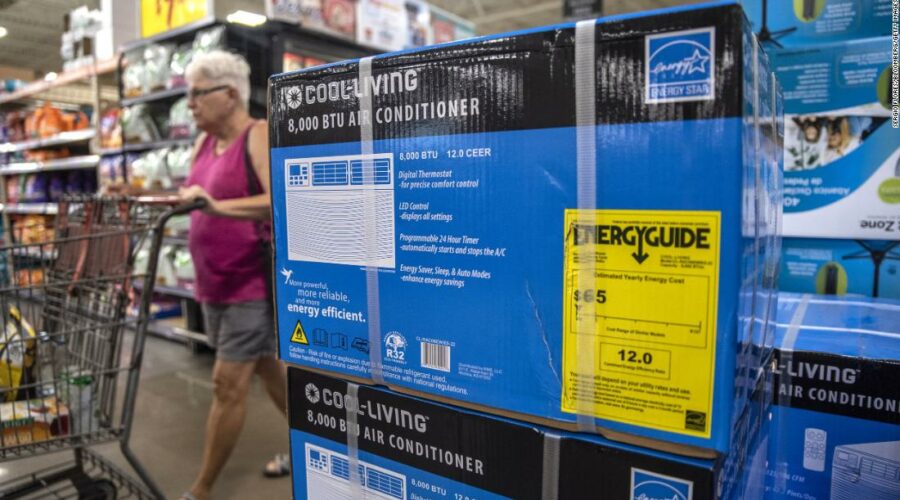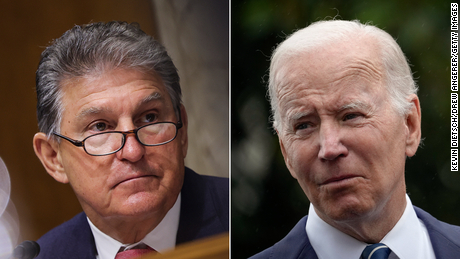New tax credits will cover 30% of the cost of highly efficient air conditioners, water heaters, furnaces and other home heating cooling appliances.
(CNN)Democrats’ new party-line tax and clean energy bill is a big deal for climate and energy savings. With nearly $370 billion for energy programs and tax incentives, it represents the largest climate investment in US history.
In addition to the US emissions reductions these will bring, there’s a lot in the bill that could change both how Americans power their homes and what kinds of vehicles they drive.
The bill contains a bevy of tax incentives aimed at pushing consumers, developers, small businesses and others towards clean energy and more efficient energy usage — helping bring down the cost of buying electric vehicles, heat pumps, water heaters, rooftop solar panels and more.
These measures would be more comprehensive than existing weatherization programs, and several would be available to all households, not just low-income ones,” said Mark Wolfe, executive director of the National Energy Assistance Directors Association.
Clean electricity nonprofit Rewiring America recently estimated a US household would save $1,800 per year if they installed electric heat pumps to heat their water and heat and cool their air, replaced a gas car with an EV, and installed solar.
The tax credits work in another way to bring down costs: incentivizing cheaper clean electricity powered by renewables.
“There are people who are really on the front lines of the inflation crisis and how expensive fossil fuels are because of Putin’s invasion of Ukraine, and this bill will be delivering big energy savings for those people,” Leah Stokes, a senior policy advisor at Evergreen and associate professor of political science at the University of California, Santa Barbara, told reporters recently.
Here are the main pieces of the bill that help consumers save money.
Savings on buying an electric vehicle: The bill extends the current $7,500 tax credit for a new vehicle, as well as a $4,000 tax credit off a used EV. It also gets rid of the current cap that cuts automakers off tax credits after they’ve sold 200,000 EVs, and it is written so buyers can get an immediate discount at the dealership, instead of waiting weeks or months for their tax credit to come through.
Still, there’s a significant caveat: Automakers and consumers likely won’t be able to take advantage of this tax credit over the next few years. At the insistence of Democratic Sen. Joe Manchin, the tax credit was written in a way so that automakers are forced to move their EV supply chains away from China and to the US and countries where the US has free trade agreements. Vehicles must be built in North America, and EV batteries must also not come from countries like China.
As a result, US automakers likely won’t be able to offer the credit in the next few years as they try to build up their domestic supply chains, Democratic Sen. Debbie Stabenow of Michigan said.
The tax credit is also limited to trucks, vans and SUVs under $80,000, and other vehicles under $55,000, and has an income threshold for consumers.
Help installing more efficient air conditioning and heating equipment: The bill would provide Americans with tax credits to cover 30% of the costs of installing highly efficient ACs, water heaters, furnaces and other cooling and heating equipment.
Households would be able to receive up to $600 for each piece of equipment, up to $1,200 total per year. There would also be a special credit of up to $2,000 for electric heat pumps. And credits could be used to upgrade breaker boxes, if needed, to handle additional electric load.
This measure replaces a similar tax credit that expired at the end of last year and came with a lifetime cap of $500.
Aid for low- and moderate-income Americans to purchase electric appliances: The legislation calls for providing low- and moderate-income households with rebates of up to $14,000 to buy electric appliances.
The rebates could cover between half and all the typical $14,000 cost of installing an electric heat pump, as well as much of the cost of electric water heaters, stoves and ovens and clothes dryers, as well as upgrading the home’s breaker boxes and electric wiring. The legislation sets aside $4.5 billion over 10 years for this provision.
To alleviate concerns that low-income households would have to pay for the items up front, rebates could be provided at the point of sale or contractors could claim them, for example. It would depend on how state energy offices, which would administer the rebates, would set up their programs.
Rebates for retrofitting homes: Households could receive rebates of up to $4,000 to install energy-saving measures throughout their homes, under the bill. Low- and moderate-income Americans could receive up to $8,000. The rebate amount would depend on the estimated savings that would be achieved. The legislation would provide a total of $4.3 billion in funding over 10 years.
Tax credits to reduce energy leakage: Americans could receive tax credits to cover 30% of the costs of home improvements that reduce energy leakage, such as updated windows, doors, insulation and other weatherization measures, under the bill. They could get a credit of up to $600 per improvement and a total of $1,200 per year. Plus, they could receive a $150 credit to have a home energy audit conducted. The credit would be expanded so families could use it multiple times to make upgrades over time.
Boosting efficiency in HUD housing: The bill would provide $1 billion in grants and loans to affordable housing units administered by the Department of Housing and Urban Development to increase energy or water efficiency, improve indoor air quality, make clean energy or electrification upgrades or address climate resilience needs. The improvements could include insulation, HVAC upgrades, flood-proofing, storm resistance, water-saving changes and the installation of solar or other renewable energy systems
Tax credits for developers to build energy efficient homes: Builders could receive tax credits of $2,500 for single-family or manufactured homes and $500 for units in multi-family buildings for constructing Energy Star-certified housing. Developers could get $2,500 for each multifamily unit if prevailing wage requirements are met.
The credits would double if the homes or units are also certified under the Department of Energy’s zero-energy ready home program.
A credit of up to $2,000 for building energy efficient homes expired at the end of last year.
Installing solar panels on homes: Tax credits in the bill will cover 30% of the cost of buying a rooftop solar system and home battery storage. The average cost of a rooftop solar system is around $20,000, according to the Solar Energy Industries Association. But that upfront cost will result in energy bill savings every year and add value to a home.
For those who live in apartments or can’t install solar on their roofs, there are other ways to get solar energy and lower energy bills, including leasing a rooftop solar system or joining a community solar farm to get power delivered. Tax credits in the bill increase for solar projects in low-income communities as well.
Small business incentives: Small businesses can get tax deductions of up to $1 per square foot of their business to make the space more energy efficient. They can get tax credits that cover up to 30% of the cost to replace fleets of cars and trucks with clean vehicles, as well as incentives to power their businesses with solar.
Source: Read Full Article





